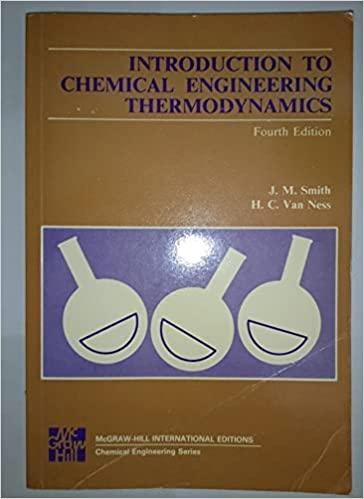Question
Scenario: Your company/research group is designing a process that involves capturing 1.08 mol methane and 1.62 mol oxygen in a rigid 35.4 L container at
Scenario: Your company/research group is designing a process that involves capturing 1.08 mol methane and 1.62 mol oxygen in a rigid 35.4 L container at 539.5K. The container is considered safe for use up to 6.0 bar and 900 K (if either is exceeded, the container is not safe).
Your job:
A) Perform a safety analysis to determine if the container can withstand accidental combustion of the contents by the reaction:
CH4 + 2O2 2H2O + CO2 + heat
B) Further, your boss is convinced that entropy is "disorder" and always tells you that your desk is evidence of the ultimate heat death of the universe. For the question at hand, your boss says that methane and oxygen are simply messier than carbon dioxide and water, and that therefore, the entropy of the products must be less than those of the reactants. You are tired of your boss's nonsense. Include entropy calculations in your analysis to subtly show your boss that they are (or are not) ridiculous.
ANSWER THIS QUESTION (use data from NIST CCCBDB):
1. Now consider the stoichiometric equivalents of water and carbon dioxide (as if all of the methane and oxygen combusted, but the temperature did not change) in an identical container at the same temperature. a) Use partition functions (and either a numerical or analytical derivative) to find the total energy for the carbon dioxide and water in the system (separately). b) What is the total internal energy of this system?
Additionally Info You May Need:
The "atomization enthalpy at 0 K" in the NIST CCCBDB is the same as "D0" in the book. To find "De" (for the electronic partition function) you have to add the ground state vibrational energy. This is given on the CCCBDB page for the molecules under the vibrational frequencies. Please note that the ground state vibrational energy is given in cm-1, whereas the atomization energy is given in kJ/mol, so you need to convert these into a De with units of Joules (if you want to use kT in Joules).
Several of the vibrational modes of methane are degenerate. On the NIST CCCBDB page the types of modes are named A1, E, T2, and T2 (we can call the T2's "T2a" and "T2b" for now). A1 is singly degenerate, E is doubly degenerate, and each of the T2's are triply degenerate. This means that:
= 1222222,
or alternatively:
= 1()2(2)3(2)3
Step by Step Solution
There are 3 Steps involved in it
Step: 1

Get Instant Access to Expert-Tailored Solutions
See step-by-step solutions with expert insights and AI powered tools for academic success
Step: 2

Step: 3

Ace Your Homework with AI
Get the answers you need in no time with our AI-driven, step-by-step assistance
Get Started


